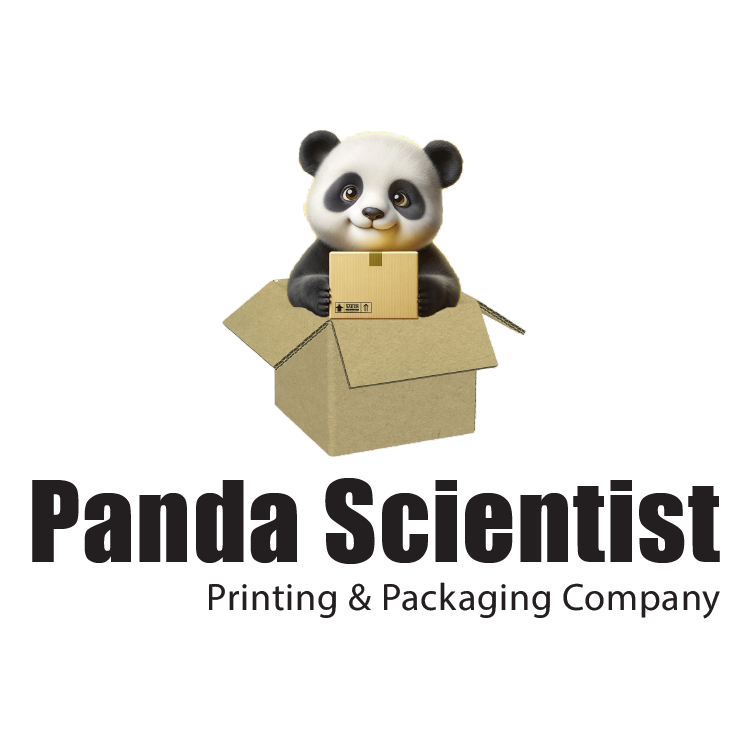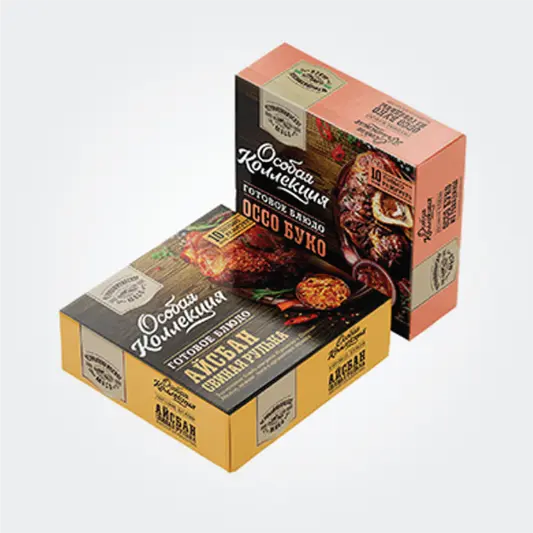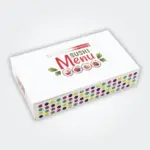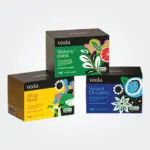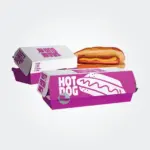Frozen Food Boxes
Custom Frozen Food Boxes
Keep the freshness locked in with our Custom Frozen Food Boxes. Specifically engineered to withstand the rigors of freezing temperatures, these boxes ensure your food remains as delectable as the day it was packed. Catering to a diverse range of frozen delights, from veggies and fruits to gourmet meals and desserts, our packaging stands as a testament to quality and integrity. Choose from designs that exude icy cool aesthetics or ones that bring warmth to the chilly contents. With the perfect blend of robust construction and captivating visuals, our Custom Frozen Food Boxes redefine the cold storage experience, promising unmatched freshness and appeal.
Frozen Food Boxes
Frozen food boxes, having carved a significant niche in today’s fast-paced world, have necessitated a packaging solution that is both efficient and protective. The frozen food boxes stand as a testament to this need, ensuring the essence of the food remains untainted. Their complex design and structure play an intricate dance of retaining freshness while facilitating consumer convenience.
Maintaining Product Integrity
The journey of a frozen product, from the factory to the freezer at home, is fraught with challenges. Ensuring the food remains in optimal condition requires packaging that can counter moisture, temperature fluctuations, and external contaminants. Frozen food boxes, crafted from robust materials like high-quality cardboard or specialized plastic, act as the first defense against these adversaries. Their impermeable nature deters ice crystals and freezer burn, ensuring that the food’s flavors, textures, and nutrients stay locked in, regardless of the storage duration.
Safety and Hygiene
Food safety is paramount, and any compromise can lead to health concerns. The materials chosen for frozen food boxes undergo rigorous testing to ensure they meet food safety standards. This means no toxic chemicals, no risk of contamination, and complete protection against external pollutants. The sealed environment they offer further acts as a bulwark against potential microbial contaminants, providing consumers with peace of mind whenever they reach for their favorite frozen delicacy.
Efficient Storage
Every inch count in a freezer, especially when it’s packed with various products. Understanding this space crunch, frozen food boxes are tailored for stackability and efficient storage. Their designs, typically rectangular or square, are optimized for maximum space utilization, allowing consumers to store more while navigating their freezer contents easily. The uniformity in shape also aids retailers in showcasing products attractively in store freezers.
Consumer Information
Consumers crave detailed information about what they consume in the era of informed choices. Frozen food boxes rise to the occasion, serving as comprehensive information hubs. They elucidate on ingredients, nutritional breakdown, potential allergens, and more. Moreover, given the unique nature of frozen foods, these boxes provide meticulous guidelines on defrosting, cooking, or reheating procedures, ensuring consumers experience the intended flavor and texture profiles. QR codes and interactive elements are sometimes added to provide additional recipes or tips, enriching the consumer’s culinary journey.
Brand Visibility and Appeal
With many frozen foods options vying for attention, standing out becomes imperative. This is where the visual design of the frozen food box comes into play. These boxes command attention through a blend of vivid colors, captivating graphics, appetizing product imagery, and clear brand insignia. Some even integrate transparent sections or windows, borrowed from the concept of window boxes, to allow consumers a peek inside, further amplifying their trust in the product’s quality.
Sustainability and Responsibility
The environmental footprint of packaging materials is a growing concern. Leading brands are acknowledging this by steering their frozen food boxes towards sustainability. From using recycled materials and biodegradable plastics to adopting minimalistic designs that reduce waste, the focus is clear. These eco-friendly strides minimize the strain on the environment and resonate deeply with eco-conscious consumers, establishing a brand image rooted in responsibility.
Innovation and User Experience
The realm of frozen food boxes is not static. It’s continuously evolving, with innovations aimed at elevating user convenience. Features like easy-to-open tabs, zip-lock systems for resealability, or portioned compartments cater to the modern-day consumer’s needs. Such design nuances make accessing and storing the food seamless, enhancing the overall user experience and ensuring brand loyalty.
Frozen Food Shipping Boxes
The e-commerce revolution and the rising popularity of frozen foods have spotlighted the necessity for specialized packaging. Frozen food shipping boxes are not just cardboard containers; they’re meticulously designed fortresses ensuring the food reaches its destination just as fresh as when it left the warehouse.
Optimal Insulation
The primary role of any frozen food shipping box is to provide insulation, keeping the warmth out and the cold in. Styrofoam, thick insulated padding, or even specialized gels are commonly used. This insulation is crucial. Imagine ordering a gourmet frozen pizza, only to arrive partially thawed and compromised. Effective insulation ensures products are received in the intended condition, from taste and texture to nutritional integrity.
Robustness and Durability
Shipping processes can be harsh. Packages might be dropped, stacked under heavy objects, or subjected to rough handling. Shipping boxes for frozen food are engineered for resilience. Their robust construction ensures they can withstand the rigors of transit. More than just protection against physical forces, this durability ensures no breach in the box’s insulating properties, a critical aspect of keeping the content frozen.
Moisture Resistance
Moisture is an enemy when it comes to shipping frozen items. From thawing products, melting ice packs, or even the ambient humidity, moisture can compromise the food inside and the box’s strength. Advanced materials and construction methods ensure that these boxes resist moisture effectively. This not only maintains the quality of the food but also ensures that the box stays soggy and retains its structural integrity.
Customizable Sizes
Frozen food is diverse. You might be shipping bulky items like whole turkeys or delicate ones like ice cream cones. The variety demands flexibility in packaging. Manufacturers offer frozen food shipping boxes in multiple sizes and designs. Customizable dimensions ensure that products fit snugly, minimizing air pockets that could compromise temperature stability.
Informative Labeling
These boxes are also ambassadors of information. Clear and detailed labels often adorn the exterior, providing crucial insights ranging from handling instructions and best-before dates to nutritional information. In an age where consumers demand transparency, such labels provide reassurance about product quality and safety. Additionally, informative stickers or indications about the contents being perishable or needing immediate refrigeration can guide handlers and recipients alike.
Eco-friendly Alternatives
Environmental concerns are reshaping industries, and packaging is no exception. Many producers now offer eco-friendly shipping boxes, recognizing the global push towards sustainability. These might be made from recycled materials, use biodegradable insulating agents, or incorporate sustainable production processes. Such initiatives don’t just reduce environmental footprints; they also appeal to a growing segment of environmentally-conscious consumers.
Enhanced Sealing Mechanisms
A frozen food shipping box’s seal is its final line of defense. It keeps the cold and warm air in and ensures no contaminants find their way inside. Advanced sealing techniques are now in play, from high-quality adhesive tapes designed for cold environments to innovative lock mechanisms. Such seals ensure the box’s internal environment remains pristine, protecting the frozen treasures.
Custom Frozen Food Boxes
As consumer preferences shift and the frozen food market evolves, businesses continually seek innovative ways to differentiate their products. One effective approach is the use of custom frozen food boxes. These specialized packages preserve the quality and freshness of the food and serve as a potent branding tool, giving producers a distinct edge in a competitive market.
Uniquely Designed for Product Protection
Every frozen product has its nuances. Whether gourmet ice cream, a pre-cooked meal, or fresh-frozen vegetables, each requires specific conditions to maintain quality. Custom frozen food boxes cater to these unique needs, incorporating specific insulation materials and structures that best suit the product they house. This precision in design ensures that the product inside remains in its optimal condition, regardless of external factors.
A Canvas for Branding
Custom boxes are not just functional; they’re also a marketing canvas. A well-designed package can make all the difference in the crowded aisles of a supermarket freezer or online product listings. From vibrant graphics and unique shapes to embossed logos and captivating product descriptions, these boxes are tailored to capture attention and resonate with the brand’s ethos.
Enhanced Consumer Experience
Today’s consumers demand more than quality products; they seek experience. Custom frozen food boxes can enhance this experience manifold. Features like easy-open lids, resealable packets, or compartments for different food items can make the unboxing and consumption more enjoyable. QR codes or interactive elements can also lead consumers to recipe ideas, product origins, or even loyalty programs.
Eco-conscious Packaging Solutions
The growing awareness of environmental concerns means many brands are eager to showcase their commitment to sustainability. Custom frozen food boxes can be designed with this in mind. Whether using recycled or biodegradable materials, reducing plastic content, or adopting minimalistic designs to reduce waste, custom solutions can be functional and eco-friendly.
Optimizing Logistics and Storage
Customization also extends to the shape and size of the boxes, ensuring they’re perfectly optimized for logistics. For instance, uniform shapes can facilitate easy stacking during transport, reducing the risk of damage. At the retail level, custom boxes can be designed to use freezer shelf space best, allowing for efficient storage and attractive product display.
Tailoring to Regulatory Standards
Different regions may have varying regulatory standards when it comes to food packaging. Custom frozen food boxes can be designed keeping these in mind, ensuring all mandatory information, safety standards, and certifications are displayed. This not only ensures compliance but also builds consumer trust.
Frozen Food Boxes Recyclable
The era of sustainable practices has dawned upon us, with industries worldwide taking accountability for their ecological footprint. The packaging sector, especially the frozen food segment, has been included. As consumers grow more environmentally conscious, there is a rising demand for frozen food boxes that are effective in preserving product quality and recyclable. Here’s a dive into the world of recyclable frozen food boxes and why they’re becoming the need of the hour.
The Environmental Impact of Traditional Packaging
Historically, frozen food packaging has been designed purely for optimal insulation and preservation. This often led to using multi-layered materials, including plastics, foils, and other non-recyclable components. The accumulation of such packaging in landfills has had detrimental environmental consequences, contributing to long-term pollution and ecosystem disruption.
Recyclable Materials and their Efficacy
As the shift towards sustainable practices intensifies, several materials emerge as eco-friendly alternatives for frozen food packaging. Cardboard, kraft paper, and even certain bioplastics are proving effective. When used in conjunction with natural insulating agents like cellulose or wool, these materials can maintain the requisite temperature inside the box while being environmentally benign.
Consumer Demand and Brand Image
Today’s consumers are not just buying a product but investing in brands that resonate with their values. A commitment to recyclable packaging signifies environmental responsibility, which can enhance brand image and loyalty. Many consumers are even willing to pay a premium for products that prioritize eco-friendly practices, making switching to recyclable frozen food boxes a wise business move.
Challenges and Innovations
Switching to recyclable packaging has its challenges. Ensuring the same food safety, moisture resistance, and durability level as traditional materials can be demanding. However, continuous research and innovation have led to creation of recyclable materials that are coated or treated to offer these properties. As technology advances, the gap between the efficacy of traditional and recyclable packaging is narrowing.
Regulatory Incentives
Governments and regulatory bodies are increasingly championing sustainable practices. Tax incentives, grants, or even certifications for eco-friendly practices are becoming common. Adopting recyclable frozen food boxes helps in compliance and provides tangible financial benefits to businesses.
The Future of Recyclable Frozen Food Boxes
With a collaborative effort between material scientists, packaging designers, and industry stakeholders, the journey toward completely recyclable frozen food packaging seems promising. As the benefits – both environmental and business-oriented – become more apparent, the industry is poised to witness a paradigm shift in its packaging practices.


